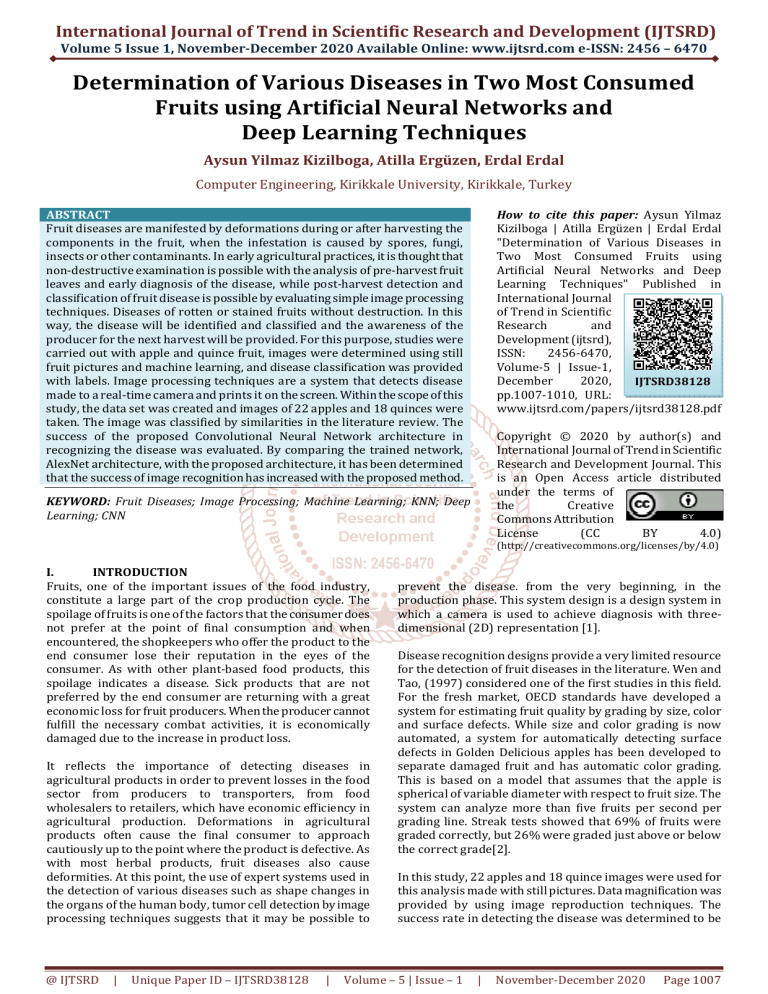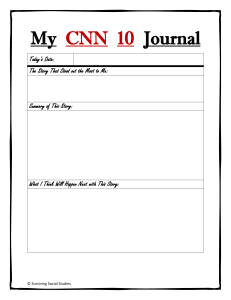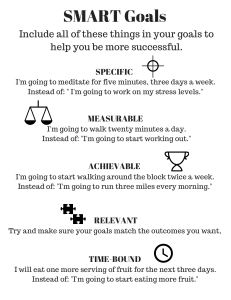
International Journal of Trend in Scientific Research and Development (IJTSRD)
Volume 5 Issue 1, November-December 2020 Available Online: www.ijtsrd.com e-ISSN: 2456 – 6470
Determination of Various Diseases in Two Most Consumed
Fruits using Artificial Neural Networks and
Deep Learning Techniques
Aysun Yilmaz Kizilboga, Atilla Ergüzen, Erdal Erdal
Computer Engineering, Kirikkale University, Kirikkale, Turkey
How to cite this paper: Aysun Yilmaz
Kizilboga | Atilla Ergüzen | Erdal Erdal
"Determination of Various Diseases in
Two Most Consumed Fruits using
Artificial Neural Networks and Deep
Learning Techniques" Published in
International Journal
of Trend in Scientific
Research
and
Development (ijtsrd),
ISSN:
2456-6470,
Volume-5 | Issue-1,
December
2020,
IJTSRD38128
pp.1007-1010, URL:
www.ijtsrd.com/papers/ijtsrd38128.pdf
ABSTRACT
Fruit diseases are manifested by deformations during or after harvesting the
components in the fruit, when the infestation is caused by spores, fungi,
insects or other contaminants. In early agricultural practices, it is thought that
non-destructive examination is possible with the analysis of pre-harvest fruit
leaves and early diagnosis of the disease, while post-harvest detection and
classification of fruit disease is possible by evaluating simple image processing
techniques. Diseases of rotten or stained fruits without destruction. In this
way, the disease will be identified and classified and the awareness of the
producer for the next harvest will be provided. For this purpose, studies were
carried out with apple and quince fruit, images were determined using still
fruit pictures and machine learning, and disease classification was provided
with labels. Image processing techniques are a system that detects disease
made to a real-time camera and prints it on the screen. Within the scope of this
study, the data set was created and images of 22 apples and 18 quinces were
taken. The image was classified by similarities in the literature review. The
success of the proposed Convolutional Neural Network architecture in
recognizing the disease was evaluated. By comparing the trained network,
AlexNet architecture, with the proposed architecture, it has been determined
that the success of image recognition has increased with the proposed method.
Copyright © 2020 by author(s) and
International Journal of Trend in Scientific
Research and Development Journal. This
is an Open Access article distributed
under the terms of
the
Creative
Commons Attribution
License
(CC
BY
4.0)
KEYWORD: Fruit Diseases; Image Processing; Machine Learning; KNN; Deep
Learning; CNN
(http://creativecommons.org/licenses/by/4.0)
I.
INTRODUCTION
Fruits, one of the important issues of the food industry,
constitute a large part of the crop production cycle. The
spoilage of fruits is one of the factors that the consumer does
not prefer at the point of final consumption and when
encountered, the shopkeepers who offer the product to the
end consumer lose their reputation in the eyes of the
consumer. As with other plant-based food products, this
spoilage indicates a disease. Sick products that are not
preferred by the end consumer are returning with a great
economic loss for fruit producers. When the producer cannot
fulfill the necessary combat activities, it is economically
damaged due to the increase in product loss.
It reflects the importance of detecting diseases in
agricultural products in order to prevent losses in the food
sector from producers to transporters, from food
wholesalers to retailers, which have economic efficiency in
agricultural production. Deformations in agricultural
products often cause the final consumer to approach
cautiously up to the point where the product is defective. As
with most herbal products, fruit diseases also cause
deformities. At this point, the use of expert systems used in
the detection of various diseases such as shape changes in
the organs of the human body, tumor cell detection by image
processing techniques suggests that it may be possible to
@ IJTSRD
|
Unique Paper ID – IJTSRD38128
|
prevent the disease. from the very beginning, in the
production phase. This system design is a design system in
which a camera is used to achieve diagnosis with threedimensional (2D) representation [1].
Disease recognition designs provide a very limited resource
for the detection of fruit diseases in the literature. Wen and
Tao, (1997) considered one of the first studies in this field.
For the fresh market, OECD standards have developed a
system for estimating fruit quality by grading by size, color
and surface defects. While size and color grading is now
automated, a system for automatically detecting surface
defects in Golden Delicious apples has been developed to
separate damaged fruit and has automatic color grading.
This is based on a model that assumes that the apple is
spherical of variable diameter with respect to fruit size. The
system can analyze more than five fruits per second per
grading line. Streak tests showed that 69% of fruits were
graded correctly, but 26% were graded just above or below
the correct grade[2].
In this study, 22 apples and 18 quince images were used for
this analysis made with still pictures. Data magnification was
provided by using image reproduction techniques. The
success rate in detecting the disease was determined to be
Volume – 5 | Issue – 1
|
November-December 2020
Page 1007
International Journal of Trend in Scientific Research and Development (IJTSRD) @ www.ijtsrd.com eISSN: 2456-6470
83%, and the test was applied in two stages and the success
result in the K-Nearest Neighbor (K-NN) method was found
81% among the classes determined in the data set.
The main purpose of this study is to facilitate the detection of
fruit diseases. For this purpose, it is to design a real-time
image recognition system using convolutional neural
networks (CNN), which is a deep learning architecture. The
same system was created with the AlexNET architecture,
which has a different architecture in the same deep neural
network, and its successes were compared with the network
created within the scope of this study.
II.
Data Set Creation
The number of studies in which image recognition
techniques are provided for the detection of fruit diseases
worldwide is limited. The most important reasons for this
are; There are no ready-made data sets for various studies
and the data sets created are not comprehensive.
In this study, a data set of 5 classes was created for apple
using 600 images taken from two different fruits, and a data
set of 2 classes was created for quince. These are 5 fruit
diseases for apple[3]: black spot disease, alternaria disease,
worm, powdery mildew of apple, for quince: brown rot on
quince and blue mold rot on quince[4]. A, each pattern has
two different images in black and white (binary) and color
(RGB). 5/6 of the data was used for training, 1/12 for
verification and the rest for testing. In Figure 1. colored and
binary patterns are given for the sample two classes.
III.
Methods Used
A. Deep Learning
Deep Learning; Learning an artificial intelligence method that
basically uses multiple artificial neural networks, which is
used for many purposes such as natural language processing,
pattern recognition, speech recognition, is one of the types of
machine learning. This method was first used in 2006 in
Hinton et al. He used a very long-term learning term [5] and
when he was together at Aizenberg in 1999; It has been
described in detail as a nerve from the term deep learning. [6]
The expression Deep here refers to the number of layers in
the network, the more layers the more the deeper the
network is, the more processing technology for computers
and the ability to do more expensive money calculations have
made learning with graphics cards learning. Figure-2 shows a
simple deep learning model.
Figure 2 General deep learning model
Since the deep learning method has an artificial neural
network structure, it is also called deep neural networks. One
of the most important features of this structure is that it can
perform both feature extraction and classification process
itself, and it can be used only in feature extraction and then
with another classifier. Also, they can be programmed in
parallel with deep neural networks, reducing the processing
time. Otherwise, it may take much longer to process
enormous data.
Figure 3. Classical machine learning methods and
comparison of learning[7].
Figure 1 Black-white and color pictures of apple and
quince diseases patterns(The data set we created was
taken with Samsung Galaxy J7 Pro and transferred to
Intel ® Core ™ I7 -8750h CPU @ 2.20 Ghz and 16.00 GB
RAM Nvidia GTX 1050 ti Video Card and Microsoft
Windows 10 Home x64 bit operating system via
intermediate cable.)
@ IJTSRD
|
Unique Paper ID – IJTSRD38128
|
Convolutional neural networks proposed by Lecun et al. In
1998 are more suitable for 2-dimensional data such as
images. Each latent convolution filter transforms its input
into a 3-dimensional output of neuron activations. It was
developed inspired by the neurobiological model of the visual
cortex while creating convolutional neural networks. In this
sense, this network structure is more effective in visual object
Volume – 5 | Issue – 1
|
November-December 2020
Page 1008
International Journal of Trend in Scientific Research and Development (IJTSRD) @ www.ijtsrd.com eISSN: 2456-6470
recognition. There are many different models for
convolutional neural networks. Model selection is an
important factor in solving the problem. There are many
successful models designed to distinguish pictures. These are
mainly Lenet, Alexnet, Googlenet and Resnet. Together with
the CNN we created, we chose the AlexNET model designed
by Alex Krizhevsky and his group, which has a deeper
network structure than the one based on Lenet architecture,
which reduced the error rate from 26% to 15% in the Image
net competition in 2012. [7]
Figure 4 AlexNet Architecture [7]
As seen in Figure 4, this architecture basically consists of 5
convolutional layers and 3 fully connected layers. Since there
are 1000 objects in the classification layer, it consists of 1000
neurons. Filter sizes in convolution layers are 11x11, 5x5,
3x3. Activation function ReLu, max pooling in pooling layers
used to reduce the number of parameters, and momentum
Skoastic Gradient Descent (SGD) in optimization was
selected. This model, which operates on a dual GPU (Graphics
Processing Unit), calculates approximately 60 million
parameters. [7]
IV.
Made Works
Two different CNN models were used in this study. Black and
white images of 50x50 pixels were used in the entrance layer
of the CNN structure we created. In the first convolution
layer, 16 filters of 2x2 size were used. In the second
convolution layer, 32 filters of 5x5 size were used. In the
third convolution layer, 64 filters of 5x5 size are used and
there are two fully connected layers. The CNN architecture
and parameters created in Figure 5 can be seen.
The first training of the CNN structure created within the
scope of this study took approximately 2.5 hours. Since there
is a deeper network in the AlexNet structure and RGB images
are used, the training phase took 4.5 hours. The epoch
number 20 was chosen for both structures.
Figure 5 CNN architecture that occurs in Tensor flow
Again, as another CNN structure in this study; The pretrained AlexNet model is used. Thanks to the use of the
AlexNet structure, changes were made only in the
classification layer without creating CNN layers. Since this
structure was previously trained; By applying the learned
filters to the data set consisting of fruit images, the features
were extracted and the classification process was carried
out. In the input layer of the AlexNet structure, unlike the
other CNN models, a data set consisting of 227x227x3 pixel
color (RGB) images is used.
The system cuts the image of the diseased fruit placed in the
dark blue selected area through the web camera as shown in
Figure 6, gives it to the trained system and prints the
character with the highest predictive value and the score
value.
The system was developed on Intel ® Core ™ I7 -8750h CPU
@ 2.20 Ghz and Nvidia GTX 1050 ti Video Card with 16.00 GB
RAM and Microsoft Windows 10 Home x64 bit operating
system computer. Compared to other programming
languages, Python language was chosen because it allows to
write the program code with the least effort and fast, and the
software was written using the tensorflow library in
JetBrains PyCharm Community Edition 2019 1.1
environment.
Figure 6.Screen image of real-time patient fruit
recognition system
@ IJTSRD
|
Unique Paper ID – IJTSRD38128
|
Volume – 5 | Issue – 1
|
November-December 2020
Page 1009
International Journal of Trend in Scientific Research and Development (IJTSRD) @ www.ijtsrd.com eISSN: 2456-6470
Two different CNN architectures are used in this study. The
accuracy value of the test data applied to the AlexNet model
was obtained as 81.3%. In the CNN architecture proposed in
this study, more successful results were obtained with an
accuracy of 83.3%. The confusion matrix results obtained in
the proposed CNN architecture are given in Table 1.
detection, fruit production, distribution, and final breeding
delivery. The data set was created by defining 5 classes of
apple disease and 2 classes of quince disease within the scope
of this study. The models created for this were determined by
comparing them with two-stage architecture trained with
disease images. To achieve real-time tests and successful
research results, the data set will be expanded in the future
and a video-based identification system will be created to
identify other fruit diseases.
References
[1] Nakano, K. (1997). Application of neural networks to
apple color grading. Computer and Electronics in
Agriculture, 18 (2–3), 105–116.
[2]
Zhang, B., Huang, W., Li, J., Zhao, C., Fan, S., Wu, J., &
Liu, C. (2014). Computer vision principles,
developments and applications for external quality
control of fruits and vegetables: A review.
International Food Research. Elsevier Ltd.
https://doi.org/10.1016/j.foodres.2014.03.012
[3]
Banot, Mrs S. and PM, Dr. M. (2016). A fruit detection
and grading system based on image processing.
IJIREEICE, 4 (1), 47-52.
[4]
Yapay Zeka ve Derin Öğrenme A-Z : TENSORLOFW
https://www.udemy.com/course/yapayzeka/
[5]
Morrow, C., Heinemann, P., Sommer, H., Crassweller,
R., Cole, R., Tao, Y., Deck, S. (2019). Automatic control
of fruits and vegetables. HortScience, 26 (6), 712B –
712.
[6]
Krizhevsky, A., Sutskever, I. ve Hinton, G. E.,( 2012).
Image net classification with deep convolutional
neural networks, Advances in neural information
processing systems, 1097-1105.
[7]
Patel, S. ve Pingel, J., 2017, Introduction to Deep
Learning: What Are Convolutional Neural Networks?
[Online],
Math
Works.
https://www.mathworks.com/videos/introductionto-deep-learning-what-are-convolutional-neuralnetworks--1489512765771.htm
Table 1 CNN Confusion Matrix
The reason why the Alexnet network structure is less
successful is that the input images are rgb, so the depth has
tripled, so our network should be deeper or trained with
more epochs rather than keeping the number of epochs the
same.
V.
Conclusion
Fruit diseases affect the whole society, from the producer to
the end consumer. In this preliminary environment, a CNN
was designed for real-time detection of fruit disease to
reduce economic losses in the early stages of disease
@ IJTSRD
|
Unique Paper ID – IJTSRD38128
|
Volume – 5 | Issue – 1
|
November-December 2020
Page 1010



